The Thingyan Festival runs, roughly, from 13th to 16th April each year; and signifies the end of the hot, dry season, as well as the chance to take stock, reflect and wash away the previous year’s misgivings or bad luck. It’s also a time of national celebration with state and sponsor-funded gatherings including water soaking stations, music and more.
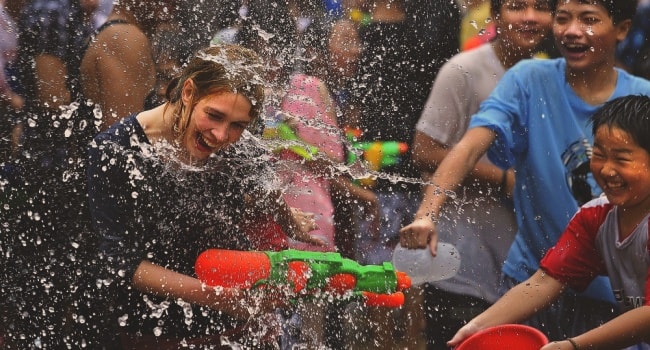
What is the meaning of Thingyan Festival – Myanmar New Year?
 Jolie LIEM
Jolie LIEM
 25/04/2024
25/04/2024
Myanmar’s answer to Thailand Songkran, Laos Boun Pimai, and Cambodia Chaul Chnam Thmey, is Thingyan Festival. It’s the annual water festival, which celebrates the coming of the new year with a nationwide display of performances, religious ceremonies and bucket loads of water. It is a sight to see and not to be missed if you are visiting the country in April.
- What is the meaning of Thingyan Festival?
- The Legend of Thingyan Festival
- Thingyan traditions and ceremonies
- Water Festival
- Modern-day Celebrations
- New Year's Day
- The Food during Thingyan
- Where to celebrate the Thingyan Festival?
- Tips for Making the Most of Thingyan
- How to survive the water fight?
- Thingyan music and song
- Thingyan Festival Date
- Similar New Year Celebration in other Asian countries
What is the meaning of Thingyan Festival?
The Legend of Thingyan Festival
The story behind Thingyan originated from the Buddhist version of a Hindu myth. The story goes that the King of Brahmas called Arsi, lost a wager to the King of Devas, Sakra (or Thagya Min as he is known in Myanmar). On losing the wager Arsi was decapitated and the head of an elephant was put onto his body (transforming him into Ganesha).
The Brahma was so powerful that if the head were thrown into the sea it would dry up immediately. If I were thrown up into the air the sky would burst into frames. Sakra therefore commanded that the Brahma’s head be carried by one princess devi after another taking turns for a year each. The New Year henceforth marked the changing of hands of Brahma’s head and is celebrated by Thingyan festival.
The legend of Thingyan is quite the same with Thailand Songkran, Lao Boun Pimai, and Khmer New Year
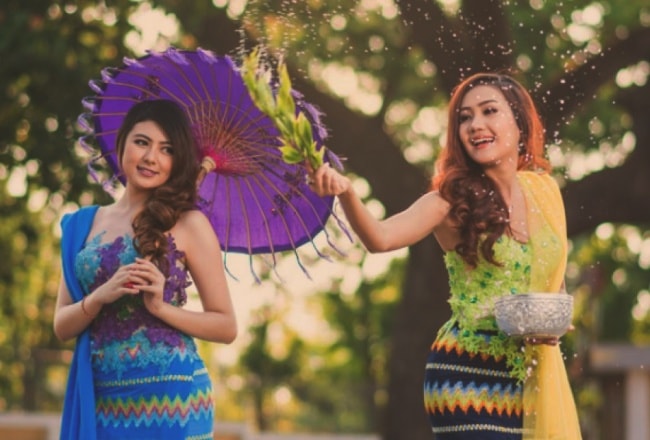
Thingyan traditions and ceremonies
The eve of the start of Thingyan, or a-kyo nei, marks the beginning of celebrations, with Buddhists expected to adhere to what’s called the Eight Precepts. This includes three additional clauses to the standard Five Precepts, which make up the basic code that Buddhists live by (think along the lines of the 10 commandments). Offerings are made to the monks as well as to shrines and images of Buddha, and it’s a time to be thankful for what the year has provided. It’s at night that things really kick off in earnest, when the festival vibe takes hold with music, dancing, and singing filling neighborhoods across the country, which last for the following few days.
Huge bamboo platforms, or pandals, are erected in the run up to Thingyan, with rows of brightly colored hose pipes dangling downwards. Often sponsored by brands, these platforms are the focus of the celebrations in each area, from quiet country roads to the center of the biggest cities such as Yangon and Mandalay. It is not until New Year’s Day, the fourth day of celebrations, that things start to settle down again as people take time to visit family and prepare themselves for the coming year. It’s usually safe to go outside if you’re trying to avoid yet another soaking, as the water throwing stops (in theory), and people focus on acts of kindness such as releasing captive birds and fish, while special feasts are held for monks.
The festival is celebrated in slightly different ways in states around the country. For example, in the Shan state to the east of Burma, it is called Sangkyan, while in Rakhine State to the west, the people observe three other traditional ceremonies, and in Mon state to the southeast, a special dish made of dried snakehead fish, onions, beeswax, and green mangoes is served up to the many. The local nuances reflect the differences between the states in Burma – each has an identity of its own.
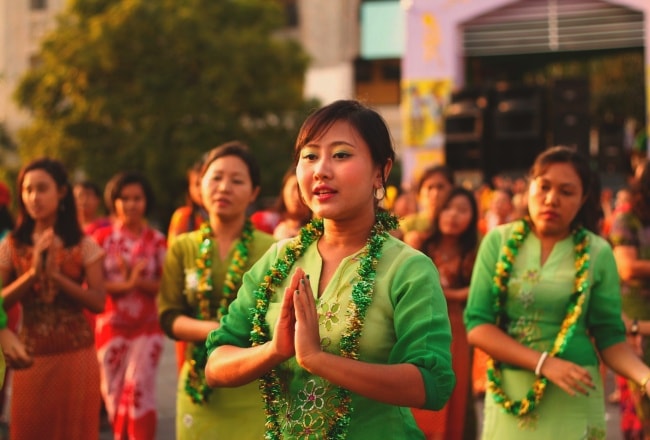
Water Festival
The next day called a-kya nei is when Thingyan fully arrives as Thagyamin makes his descent from his celestial abode to Earth. At a given signal, a cannon (Thingyan a-hmyauk) is fired and people come out with pots of water and sprigs of thabyay, then pour the water onto the ground with a prayer.
A prophecy for the new year (Thingyan sa) will have been announced by the brahmins (ponna) and this is based on what animal Thagya Min will be riding on his way down and what he might carry in his hand. Children are told that if they have been good Thagya Min will take their names down in a golden book but if they have been naughty their names will go into a dog book.
Serious water throwing does not begin until a-kya nei in most of the country although there are exceptions to the rule. Traditionally, Thingyan involved the sprinkling of scented water in a silver bowl using sprigs of thabyay (Jambul), a practice that continues to be prevalent in rural areas. The sprinkling of water was intended to metaphorically "wash away" one's sins of the previous year.
In major cities such as Yangon, garden hoses, huge syringes made of bamboo, brass or plastic, water pistols and other devices from which water can be squirted are used in addition to the gentler bowls and cups. Water balloons and even fire hoses have been employed.
It is the hottest time of the year in the country and a good dousing is welcomed by most. All able-bodied individuals are included in this game, except for monks. Some overenthusiastic young lads may get captured by women, who often are their main target, and become kids of a practical joke with soot from cooking pots smeared on their faces.
Maidens from mandats with dozens of garden hoses exchange hundreds of gallons of water with throngs of revelers and one float after another. Many travelers carry towels to block water from getting into the ears and for modesty as they get thoroughly soaked in their light summer clothes. The odd prankster might use ice water and a drive-by splash with this would be taken humorously. Pwè (performances) by puppeteers, orchestras, yein dance troupes, comedians, film stars and singers including modern pop groups are commonplace during this festival.
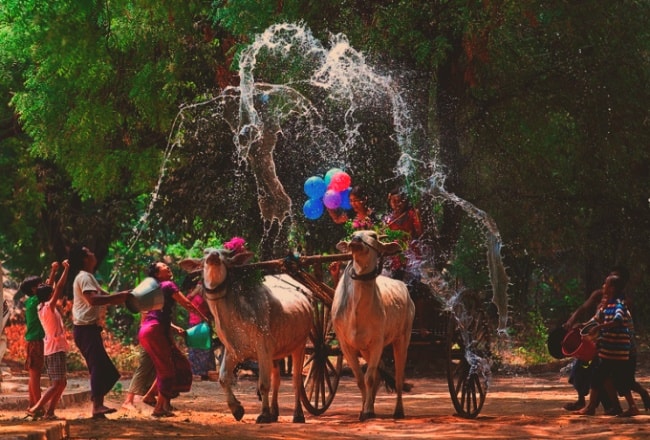
Modern-day Celebrations
During the Water Festival, the Myanmar government relaxes restrictions on gatherings. In the former capital, Yangon, the government permits crowds to gather on the Kandawgyi Pat Lann and Kabaraye Roads. Temporary water-spraying stations, known as pandals, are set up and double as dance floors. Many of these pavilions are sponsored by rich and powerful families and businesses
The third day is known as a-kyat nei and there may be two of them, as an extra day is added in certain years. The fourth day is known as a-tet nei when Thagya Min returns to the heavens, the last day of the water festival. Some would throw water at people late into the day making an excuse such as "Thagya Min left his pipe and has come back for it"! Over the long festive holiday, a time-honoured tradition is mont lone yay baw, glutinous rice balls with jaggery (palm sugar) inside thrown into boiling water in a huge wok and served as soon as they resurface which gave it the name.
Young men and women help in making it and all are welcome, some have put a bird-eyes chili inside instead of jaggery as a trick. Mont let saung is another Thingyan snack, made of bits of sticky rice with toasted sesame in jaggery syrup and coconut milk. They are both served with grated coconut. In major cities such as Yangon and Mandalay, Rakhine Thingyan can also be experienced as Rakhine residents of the city celebrate in their own tradition. Water is scooped from a long boat (laung hlei) to throw at revellers and Rakhine Mont di is served.
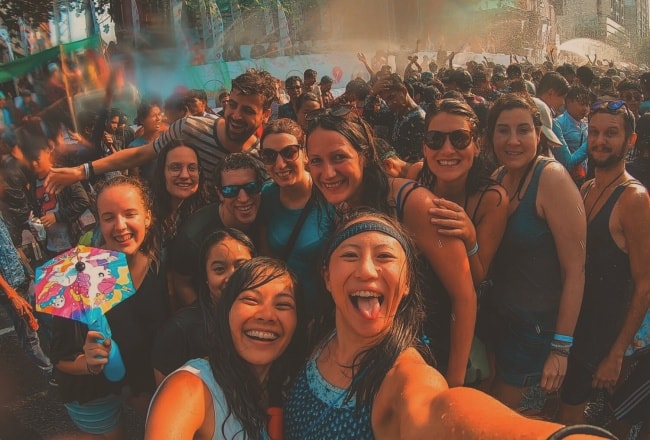
New Year's Day
The following is New Year's Day (hnit hsan ta yet nei). At this time Burmese visit elders and pay obeisance by gadaw (also called shihko) with a traditional offering of water in a terracotta pot and shampoo. Young people perform hairwashing for the elderly often in the traditional manner with shampoo beans (Acacia rugata) and bark. New year's resolutions are made, generally in the mending of ways and doing meritorious deeds for their karma.
Releasing fish ( nga hlut pwè) is another time-honoured tradition on this day; fish are rescued from lakes and rivers that are drying up, then the fish are kept in huge glazed earthen pots and jars before being released into larger lakes and rivers with a prayer and a wish saying "I release you once, you release me ten times".
Thingyan (a-hka dwin) is also a common time for shinbyu, novitiation ceremonies for boys in the tradition of Theravada Buddhism when they will join the monks (Sangha) and spend a short time in a monastery immersed in the teachings of the Buddha, the Dhamma. It is akin to rites of passage or coming of age ceremonies in other religions.
On New Year's Day, people offer food donations called satuditha at various places. They typically provide free food to those participating in the new year's celebrations.
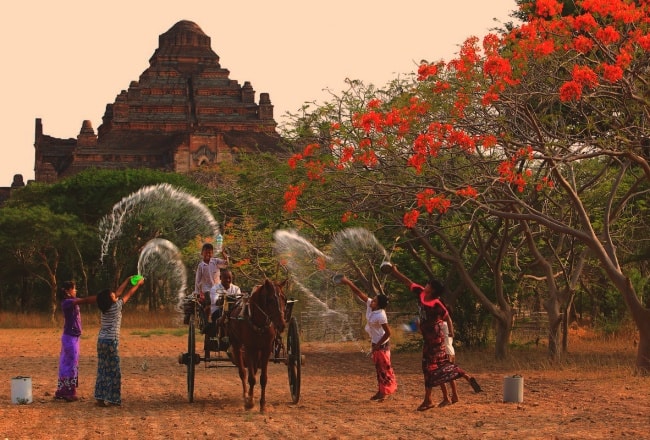
The Food during Thingyan
Over Thingyan a tradition is to cook Mont Lone Yeibaw, glutinous rice balls with jaggery (Palm sugar) inside. The whole community helps cook it; the balls are thrown into boiling water in a huge wok and served as soon as they resurface. But, watch out for pranksters putting a birdseye chilli inside of jaggery! Mont let saung is another refreshing Thingyan snack; bits of sticky rice with toasted sesame in jaggery syrup and coconut milk. They are both served with grated coconut.
Where to celebrate the Thingyan Festival?
Thingyan is the nationwide festival; it is the biggest festival in the country and a massive water fight!
Songkran is a quite well known internationally but Myanmar still holds a lot of traditions and craziness to it. The country pretty much turns of for one week, shops close and everyone gets out on the streets spraying water on each other from the morning throughout the day.
You will find the biggest parties in Yangon and Mandalay.
In Yangon, the largest city in Myanmar, the scene has been modernized and it has developed into a real party city. You will see children with water guns and pick-up trucks full up with people dancing to the heavy music with beats banging on the streets. During Thingyan, people won’t be mad of getting wet as it means washing away the bad deeds of the last year and starting the new year with a fresh mind by pouring water on each other
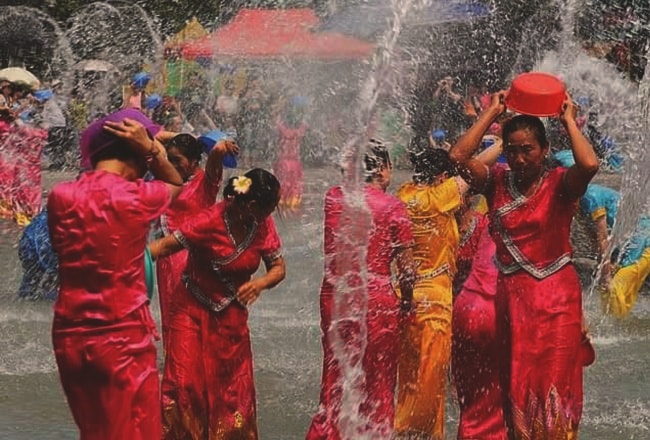
Highlights of Thingyan festival:
- There is free food distribution on the streets. You can save money on food in the day! Locals treat coffees, fried noodles and traditional Thingyan snacks like Mont Lone Yay Paw (glutinous rice balls) on the street.
- There are the splash walks in Yangon and Mandalay. In Yangon, it will take place at Inya Road including stage shows and Satudithar (free serving of food). You can go around and enjoy Burmese traditional food such as Shwe Yin Aye, Mont Lat Saung and Thingyan Rice, etc. In Mandalay, the splash walk takes place in the south part of the palace (Mya Nan San Kyaw Golden Palace) which includes entertainment programs with famous singers in the country. It’s free of charge. You will see colorful mandats (pandals).
That’s the way of how Myanmar people participate traditionally in Thingyan Festival.
If you are fond of participating in a modernized way, you can have fun on the mandats/pandals where the best DJs and musicians entertain thousands of people every day from morning till sunset. But you have to buy the tickets. The prices are around 50,000 kyats per day. Most of the mandats from Yangon are located at the venue on Pyay Road.
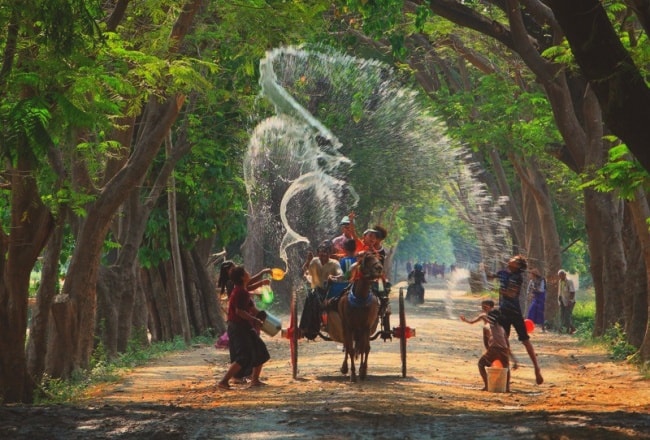
Tips for Making the Most of Thingyan
As Thingyan is at the end of the dry season, it’s unsurprising that April is the hottest month of the year in Burma; with daily highs heading towards the 40°C mark, alongside extreme heat and humidity to boot. While some people are put off visiting at this time because of the intense heat, there are big bonuses to going just outside of the peak season if you like it hot: sites can be quieter, transport easier to book, and accommodation (which is limited in terms of capacity in certain areas) more readily available. On top of this, if your trip coincides with the Thingyan Festival, you’re in for a real treat – you’d be crazy to miss it if you are planning to go in April.
There are, however, a few practicalities to consider as the country basically goes on hold for three days. While April is good overall for finding accommodation, the Thingyan Festival is a national holiday, so places get booked up quickly during this time – book your stay in advance to guarantee a hotel, guesthouse or hostel where you want.
As with accommodation, much of the country is on the move during Thingyan, so book your travel in advance whether it is by bus, train or car. For the same reason, don’t expect the cafes, restaurants or shops to be open – plan for street eats and entrepreneurial stalls surreptitiously selling overpriced, lukewarm cans of beer.
Do be prepared to chat to the locals. There’s a jovial, friendly atmosphere and, as it is one of the most welcoming countries in the world, people will want to talk to you, not to mention get you nice and wet. Which leads nicely on to the final point be prepared to get very, very wet! Don’t wear anything expensive as the water isn’t necessarily clean, and remember to dress with consideration if you’re going to be soaked to the skin; you’ll find plenty of folk selling plastic wallets for your phone so you can keep them dry while still being able to snap away.
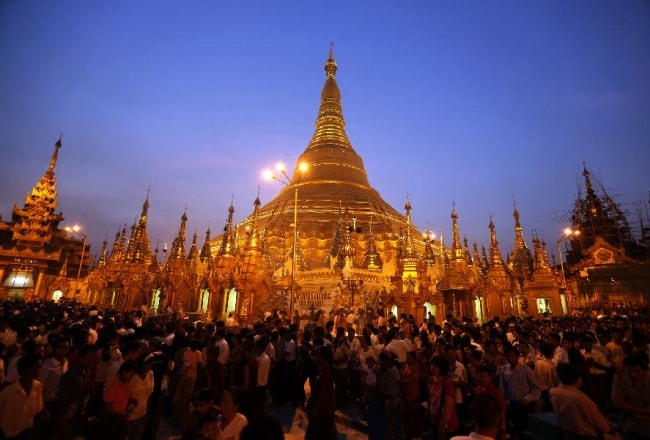
How to survive the water fight?
Thingyan Festival was a really friendly, lively festival to be a part of, but due to the water and talcum powder throwing, and alcohol intake it can also be dangerous on the roads.
There’s an increase in road traffic accidents caused by people swerving or being surprised by water attacks when on their motors or cycles. The combination of water and talcum powder also makes the road surface slippery resulting in skidding and crashes, especially when mixed with speeding and drink driving.
Personally, I would avoid riding a bicycle or motorcycle during Thingyan Festival. After being squirted directly in the face when riding my bicycle on the first day of the festival and nearly coming off it I decided the bike would remain safely at home for the rest of the celebrations. You also need to stay alert when walking around town as normal road rules don’t apply…keep your wits about you.
There’s little violent crime during Myanmar New Year but one other thing to be aware of is the increase in opportunistic pickpockets and bag snatchers, especially in the crowded areas.
There’s probably not much chance of it happening but to be on the safe side I’d recommend the following: don’t take a bag out with you, don’t carry large amounts of money and don’t walk around with your camera or phone out.
I actually just stashed my money in my bra and kept my iPhone in the waistband of my jeans. If you take these precautions you should be fine.
One other thing to remember is that Myanmar New Year falls at the hottest time of the year, so be sure to drink lots of water and wear sunscreen when out and about.
Thingyan music and song
Below are some of the most popular music and songs during Thingyan Festival.
Thingyan Festival Date
Here is the Thingyan Festival dates until 2024 for your reference.
| Year | Date | Day |
|---|---|---|
| 2021 | 13 Apr to 16 Apr | Tue to Fri |
| 2022 | 13 Apr to 16 Apr | Wed to Sat |
| 2023 | 13 Apr to 16 Apr | Thu to Sun |
| 2024 | 13 Apr to 16 Apr | Sat to Tue |
Similar New Year Celebration in other Asian countries
Thailand New Year (Songkran)
Songkran Festival is the Thai New Year’s Festival which takes place every April. It is also Thailand’s biggest and most famous water festival in Thailand. It marks the start of the traditional Thai New Year.
Songkran is derived from a Sanskrit word saṃkrānti which literally translates to “astrological passage” and means ‘passing’, ‘approaching’, ‘change’, or ‘transformation’. The official holiday runs from the 13th up to the 15th of April but the festivities may last a week or more.
The traditional way of celebrating the water festival involves Thai people splashing water on their elders, family members, close friends, and neighbors as a way of looking for good fortune. They also visit temples and pay homage to the images of Buddha.
Check more detail about Songkran – Thailand New Year
Cambodia New Year
Cambodian New Year, Choul Chnam Thmey, literally "Enter New Year", is the name of the Cambodian holiday that celebrates the traditional Lunar New Year. The holiday lasts for three days beginning on New Year's Day, which usually falls on April 13th or 14th, which is the end of the harvesting season, when farmers enjoy the fruits of their labor before the rainy season begins.
The highlight of the festive activities is also the water festival along the main streets of the big cities and all over the countries.
Check more detail about Choul Chnam Thmey – Cambodia Khmer New Year
Laos New Year (Pi Mai Lao)
Pi Mai Lao or Lao New Year is the liveliest holiday of the year and one that everyone looks forward to, as it is a time when many people visit their families all over the country. It takes place around 13-15th April, the hottest part of the year, which is why no one really minds being constantly wet from the water being thrown everywhere.
Check more detail about Boun Pimay – Laos New Year



















Jolie LIEMMy name is Jolie, I am a Vietnamese girl growing up in the countryside of Hai Duong, northern Vietnam. Since a little girl, I was always dreaming of exploring the far-away lands, the unseen beauty spots of the world. My dream has been growing bigger and bigger day after day, and I do not miss a chance to make it real. After graduating from the univesity of language in Hanoi, I started the exploration with a travel agency and learning more about travel, especially responsible travel. I love experiencing the different cultures of the different lands and sharing my dream with the whole world. Hope that you love it too!